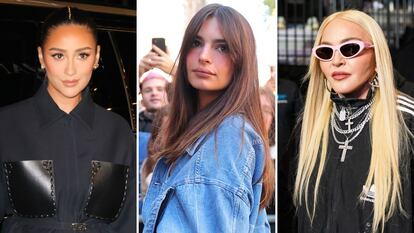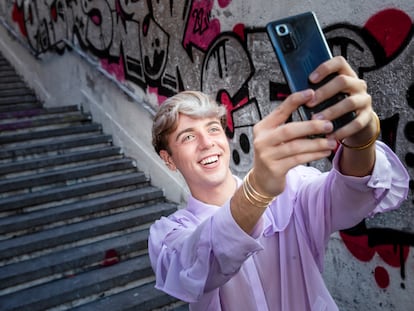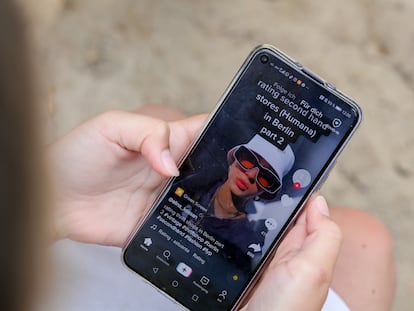Madonna, Shay Mitchell and Emily Ratajkowski use TikTok to ‘come out’ as gay: Activisim or trivialization?
Stars have begun using social media to express their sexual orientation. But some argue the messages make light of what is for many a complex or traumatic experience

October 11 was National Coming Out Day in the United States. Madonna, who has become experienced in anticipating trends, posted a video a few hours earlier on her TikTok profile. “If I miss, I’m Gay,” read the text superimposed on the clip, in which the 64-year-old singer attempted to throw a pair of panties into a garbage can. She missed. While the Vogue singer has alluded to her sexuality in the past (“I think everyone has a bisexual nature,” she told Advocate magazine in 1991), she has only publicly dated men. The TikTok video left many of her followers scratching their heads: did the queen of pop just come out of the closet, or was it a joke?
Madonna is not the only star to use TikTok to apparently express their sexual orientation. Shay Mitchell, a 35-year-old actress popular for her role in the series Pretty Little Liars, published a video with the following printed text: “If you identify as bisexual, do you own a green velvet cough?” The video showed her looking at the camera before showing off her green velvet cough. The actress and model Emily Ratajkowski posted a similar video. Like Madonna, the two of them have only had public relationships with men, which could be attributed to the need to protect their careers in a still-hostile work environment.
For years, celebrities came out of the closet through interviews. Their publicists would call a reporter, let them know they were ready to answer the question and explain their story. After a few years, the figure of the journalist became unnecessary. In 2010, singer Ricky Martin publicly came out with a post on his website. From then on, artists began to share the news themselves, in order to keep control over their narrative. Today, nobody checks celebrities’ websites. Instead, fans follow their favorite stars on social media. Social networks have mutated to be more visual, faster, less reflective. That evolution has made coming out of the closet less solemn today than it was a few years ago. It has almost become a TikTok trend.
“Coming out of the closet should be treated with all the naturalness in the world,” explains Paula Iglesias, vice president of Spain’s LGTBI+ State Federation, in a telephone conversation. “But you also have to be aware that there are environments in which this is not possible. One thing is to come out of the closet as a public figure without causing drama, and another thing is to trivialize it, nearly joke about it, without taking into account that there are people who suffer from being in the closet and not being able to be who they are.” The most extreme case of this was seen last weekend, when the heterosexual soccer players Iker Casillas and Carles Puyol pretended to confess their love for one another on Twitter. When the criticism intensified, Casillas claimed that his account had been hacked, while Puyol publicly apologized.
Madonna’s case is very different. She has been a LGBTQ+ icon for decades. She talked about gay rights before they were on the agenda of any Western government. She raised awareness about the scourge of AIDS and homophobia in Russia, when the issues were still absent from the public conversation. For that reason, many people on social media have defended the diva and contextualized her video. Meanwhile, younger users who are unaware of her career have criticized the post for trivializing a difficult experience that she, from her privilege, has not had to experience.
@emrata #stitch with @shaymitchell
♬ original sound - Emrata
“It’s a fine line,” concedes Iglesias. “Coming out of the closet is not that simple. It isn’t like throwing a ball and if it falls on one side I’m LGBT and if it falls on the other I’m not. Each one has its ways, its times and its spaces. You cannot judge the way in which people come out of the closet, but when you are a public figure, you have to be aware of the media power you have.” Going through the newspaper library and social networks, we come to the conclusion that you never come out of the closet to everyone’s liking.
Ana Amigo Ventureira, researcher and author of Biciosas, believes that the unprejudiced videos of these artists help reduce homophobia. “We must empathize with the tears and the difficulties, because they have been and continue to be there. But we also need to do it with euphoria and joy, because they have enormous revolutionary potential and also reflect many of our experiences,” she explains.
According to Amigo Ventureira, the message from Madonna, Mitchell and Ratajkowski is no less powerful because it is celebratory, but rather because it lacks context. The TikTok videos have no political message, nor even an explanation, beyond showing a green sofa or pink panties that miss a wastebasket. Actress Jamie Lee Curtis stated in a recent interview: “I have a trans daughter. There are threats against her life, just for existing as a human being. There are people who want to annihilate her.” Meanwhile, fellow actress Susan Sarandon explained to presenter Jimmy Fallon that she has both cats and dogs because “I’m bi, so…”
“Personally, I would have loved it if Susan claimed the bisexual label again after that program and that she had done it with a clearly political discourse,” says Amigo Ventureira. “But I understand that each person is different, they have gone through very different experiences and approach these issues however they decide. Or however they can.”
More and more LGBTQ+ figures are coming out in the public, without making any big announcement. They haven’t needed trends on TikTok or a National Coming Out Day. Paula Iglesias that this is the ideal situation: “We should not focus on promoting coming out, but on eradicating the assumption of heterosexuality.”
Tu suscripción se está usando en otro dispositivo
¿Quieres añadir otro usuario a tu suscripción?
Si continúas leyendo en este dispositivo, no se podrá leer en el otro.
FlechaTu suscripción se está usando en otro dispositivo y solo puedes acceder a EL PAÍS desde un dispositivo a la vez.
Si quieres compartir tu cuenta, cambia tu suscripción a la modalidad Premium, así podrás añadir otro usuario. Cada uno accederá con su propia cuenta de email, lo que os permitirá personalizar vuestra experiencia en EL PAÍS.
¿Tienes una suscripción de empresa? Accede aquí para contratar más cuentas.
En el caso de no saber quién está usando tu cuenta, te recomendamos cambiar tu contraseña aquí.
Si decides continuar compartiendo tu cuenta, este mensaje se mostrará en tu dispositivo y en el de la otra persona que está usando tu cuenta de forma indefinida, afectando a tu experiencia de lectura. Puedes consultar aquí los términos y condiciones de la suscripción digital.
More information
Últimas noticias
Welcome to the post-religion era: The idea of Christianity as the absolute truth has become obsolete
‘I thought you would like it’: The risky sexual practice popularized by TV shows and TikTok
The digitalization of tourism: ‘They promise experiences and gave us the worst possible one’
Mexican peso defies uncertainty with forecasts of a new period of stability in 2026
Most viewed
- Sinaloa Cartel war is taking its toll on Los Chapitos
- Reinhard Genzel, Nobel laureate in physics: ‘One-minute videos will never give you the truth’
- Oona Chaplin: ‘I told James Cameron that I was living in a treehouse and starting a permaculture project with a friend’
- Why the price of coffee has skyrocketed: from Brazilian plantations to specialty coffee houses
- Silver prices are going crazy: This is what’s fueling the rally











































